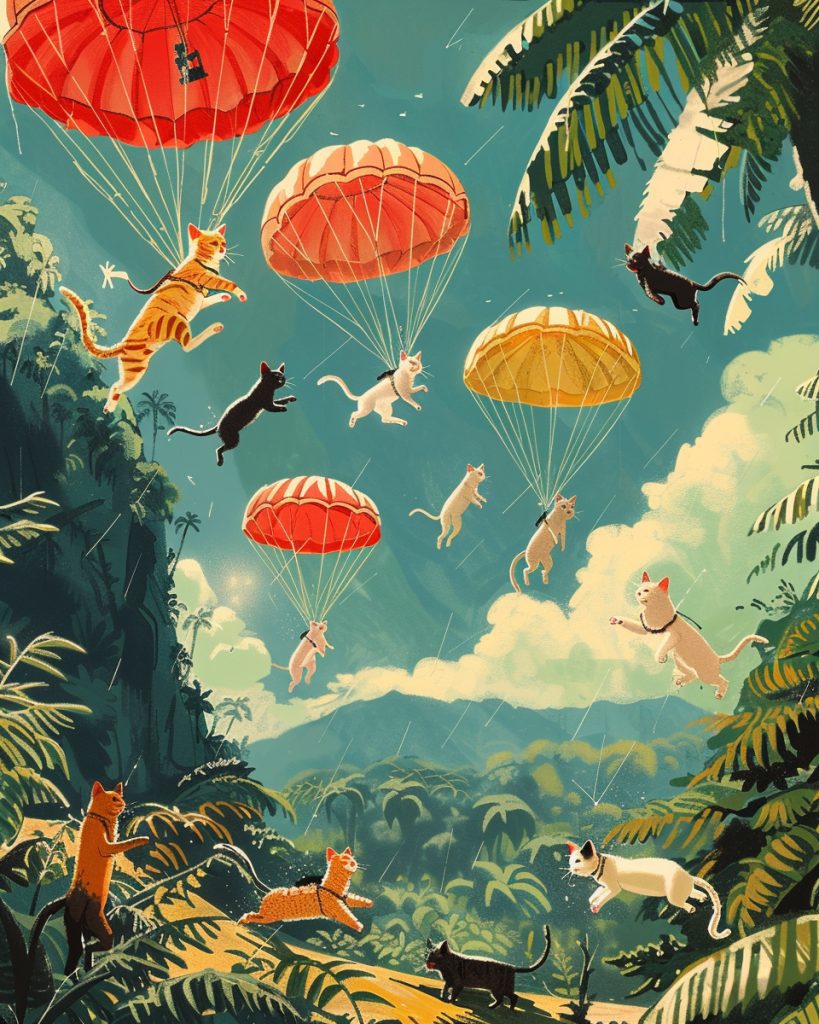In 1960, a peculiar operation unfolded in Borneo that would later be known as “Operation Cat Drop.” The Royal Air Force, in an unprecedented move, parachuted cats into Sarawak to combat a burgeoning rat problem.
This unusual strategy emerged as an unintended consequence of earlier human intervention, showcasing the intricate web of ecological relationships that often elude our understanding.
The operation involved dropping crates of cats from aircraft, a solution as unconventional as it was desperate, to address a crisis that had spiraled out of control due to the use of DDT to combat malaria.
The insecticide had decimated the local cat population, leading to an explosion in rat numbers that threatened both structures and human health. This scenario serves as a stark reminder of the unforeseen ripple effects our actions can have on complex ecosystems.
The tale of Operation Cat Drop invites us to ponder nature’s delicate balance and the far-reaching consequences of our attempts to manipulate it. It raises questions about the wisdom of quick-fix solutions and the importance of holistic thinking in environmental management.
As we delve deeper into this fascinating episode, we’ll uncover the lessons it holds for modern conservation efforts and our approach to solving global challenges.
The Essence of Operation ‘Cat Drop’
Operation Cat Drop stands as a remarkable tale of ecological intervention, blending ingenuity with unintended consequences. This unique mission saw cats parachuting from planes to combat an unforeseen pest problem.
Historical Background
In the 1950s, Borneo faced a dire situation. The World Health Organization had launched a campaign to eradicate malaria, spraying DDT across the island. This chemical warfare against mosquitoes seemed successful at first, but nature had other plans.
The DDT decimated the wasp population, leading to an explosion of caterpillars that devoured thatched roofs. Geckos feasting on poisoned insects became easy prey for cats, which in turn perished. With felines out of the picture, rats multiplied exponentially, bringing diseases and destruction.
The British Royal Air Force stepped in with an audacious plan. They would airdrop cats into remote villages to restore balance. This operation, dubbed ‘Cat Drop’, became a pivotal moment in ecological intervention.
Analysis of the Operation’s Strategy
The strategy behind Operation Cat Drop was both simple and profound. By reintroducing predators, the British aimed to curb the rat population naturally. This approach recognized the interconnectedness of ecosystems and sought to rectify the imbalance caused by human intervention.
The operation’s success hinged on careful planning. Cats were selected for their hunting prowess and ability to adapt to new environments. They were parachuted in crates, ensuring safe landings in remote areas unreachable by conventional means.
While exact numbers vary, reports suggest anywhere from 20 to 14,000 cats were deployed. This wide range reflects the operation’s mythical status and the challenges of documenting such an unusual mission. Regardless of the precise figure, Operation Cat Drop exemplifies how creative problem-solving can address complex ecological issues.
Consequences and Legacy
Operation Cat Drop had far-reaching effects that extended well beyond its initial scope. The mission’s outcomes reshaped environmental management practices, influenced local economies, and set a precedent for unconventional problem-solving in complex ecosystems.
Environmental Impact
The parachuting of cats into Borneo led to a rapid decrease in the rat population, restoring ecological balance. This intervention demonstrated the delicate interconnectedness of species within an ecosystem.
The operation highlighted the unintended consequences of DDT use. It revealed how chemical interventions can disrupt entire food chains, causing cascading effects through multiple trophic levels.
The success of Operation Cat Drop sparked interest in biological pest control methods. It inspired researchers to explore natural predator-prey relationships as alternatives to chemical pesticides.
However, the introduction of non-native cat species raised concerns about potential impacts on local wildlife. Ecologists began studying the long-term effects of such interventions on biodiversity.
Socioeconomic Effects
The rat infestation control brought significant relief to Borneo’s agricultural communities. Crop yields improved, leading to increased food security and economic stability for local farmers.
The operation’s success boosted public trust in government initiatives. It demonstrated the authorities’ commitment to addressing rural challenges, fostering a more positive relationship between citizens and institutions.
Tourism in the region saw an unexpected uptick. Operation Cat Drop’s unusual nature attracted curious visitors, creating new economic opportunities for local communities.
However, the influx of cats led to new challenges. Some villages reported issues with feral cat populations, requiring additional resources for animal control and healthcare.
Influence on Modern Operations
Operation Cat Drop became a case study in adaptive management. It showcased the importance of flexibility and creative problem-solving in addressing complex environmental issues.
The mission inspired a shift towards holistic ecosystem management approaches.
Modern conservation efforts now consider the intricate web of relationships between species and their environment.
Military and humanitarian organizations drew lessons from the operation’s logistics.
The successful airdrop techniques influenced future supply missions in remote or disaster-stricken areas.
The story of Operation Cat Drop continues to captivate imaginations.
It serves as a powerful reminder of the law of unintended consequences and the need for thorough impact assessments in environmental interventions.

